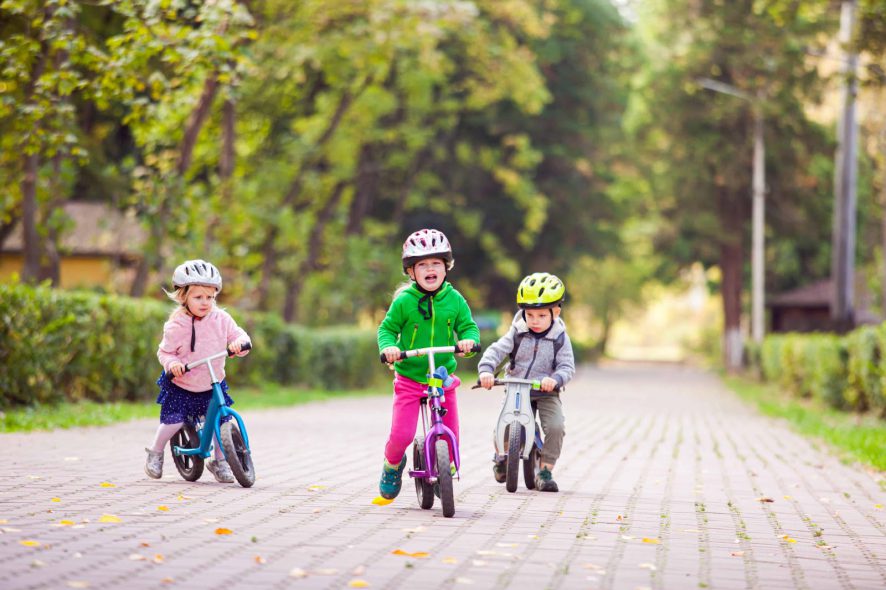
Your kid’s toddler years will be some of the most active stages of their life. They will run around a lot, ask many questions, and will want to try everything they see. Letting them explore and keeping them active is a good way to alleviate their mood and is beneficial for their overall health.
However, many parents are reluctant to let their children do things independently. Keep your child safe in their activities with the proper protective gear for kids. While biking, wearing knee pads and helmets gives your child extra protection from bumps and bruises so you can let them play without the fear of injuries.
Say goodbye to borrowed and oversized helmets. In this blog post, we’ll share what you should look for before buying a dedicated one for your toddler and how to use helmets properly.
Picking The Best Toddler Bike Helmet for Your Child
When it comes to a child’s safety, parents will always want the best. There are some things you may want to consider before getting your child their biking helmet. An expensive one isn’t always the right one. We’ll run down some of the features an excellent helmet should have so you can make a more informed purchase.
Check for safety stickers
These stickers indicate that these helmets are guaranteed to protect the user from impact by providing excellent protection. In addition, these helmets are tested multiple times to ensure the quality of protection they can give their users. Look for the Consumer Product Safety Commission sticker to ensure that the product you buy passes the proper helmet safety standards.
Choose the correct size
There are specifically designed bike helmets for kids. Don’t go into the adult aisle and buy the smallest size for your child. Your child’s helmet should be a perfect fit to maximize the protection it can give to your kids.
There are several size variations for a kid’s helmet, so pick the one that fits around their head properly. Make sure that the front of the helmet is two fingers above your child’s eyebrows, so it does not block your kid’s line of sight. Letting your child wear a big helmet blocks their line of sight which may lead to accidents, so choosing the right size matters.

Helmet shell
Most of the helmets available in the market today are made from ABS material or Acrylonitrile Butadiene Styrene. This material has shock-absorbing properties and high tensile and impact strength, making it an excellent material for helmets.
Another material you can consider is a polycarbonate shell. It shares the ABS material’s same properties, but polycarbonate is also lightweight to give the user extra comfort. Although carbon helmets are expensive because of their lightweight features, if you have no problem spending money on your child’s accessories, then this is the best safety gear money can buy.
Comfortable with good ventilation
It takes a while for your child to get used to wearing a helmet. That’s why you should get the most comfortable one for them to wear. Bike toddler helmets have inner padding for extra cushioning against bumps and impacts. Choose a helmet with enough padding for comfort and protection. Padding that’s too thick can make your child uncomfortable, while thin padding can compromise their safety.
Additionally, purchase a helmet with good airflow. Your child will sweat when they bike. Heat can cause rashes and allergies, so it’s best to choose a helmet that has good ventilation to keep your kids cool and fresh as they play.
Helmet bundle
Look for safety gear that is high quality and gives great value for your money. For example, there are toddler bike helmet sets available in the market that include knee and elbows pads for your kids, so they are protected from head to toe.

Tips for Better Helmet Use
There are several ways to maximize the use of your helmet and prolong its lifespan. Here are some tips you can use to make the most of your child’s bike helmet.
- Ensure that there are no other head accessories underneath your child’s helmet (e.g., caps, hats, and headbands), so it fits comfortably on their heads and allows for full protection.
- Avoid using stickers or paints to decorate the helmets because the extra adhesive and chemicals can weaken the outer shell, which can compromise its overall structural integrity.
- Don’t try to repair broken helmets. When the helmet experiences strong impacts, the surrounding parts are likely already weak, if not completely damaged. When you see dents or cracks in the outer shell, it’s always better to replace the helmet.
- Helmets usually last for around five years, and we recommend that you replace it even if you see no visible damage. Avoid purchasing second-hand helmets because it is hard to assess the damage when you don’t know what it’s been through.
- Don’t force your kids to wear protective gear. Instead, teach your kids to wear a helmet every time they go out and play so it becomes a habit. This will teach them the importance of wearing safety gear during outdoor activities.
- Get specialized helmets for your kids. Different kids will prefer different activities, and some will ride bikes, some will skateboard, and some will ride scooters. For every activity, there is a proper helmet. Get the right one for your kids for their utmost protection.
Final Thoughts
Let your kids enjoy the freedom of their childhood. Let them run, ride, slide and have fun under the sun without fear. Invest in a high-quality toddler bike helmet and see them go without worries.
For your children’s protective gear, check out Ashtobee’s collection of the best pads and helmets for your babies. Then, complete their set with a toddler bike and the best toys available in the market.


